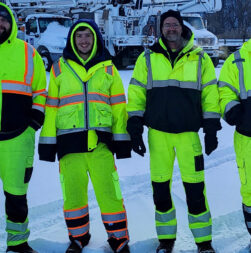Job sites are bustling hubs of activity where critical work on infrastructure occurs, and Flagger Force team members play a critical role in keeping the work moving. But job sites can also be hazardous places where steps must be taken to prevent accidents and injuries. In fact, the construction industry in the U.S. consistently ranks among the highest in terms of workplace injuries and fatalities. And that’s where the Job Safety Discussions (JSD) come in—they’re a critical practice to ensure safety and reduce risk on the job site.
In this article, we’ll explore the importance of job safety discussions and how they increase job site safety.
Construction Site Accidents
According to the U.S. Bureau of Labor Statistics, construction was the leading industry for fatal accidents in 2021 with 986. In 2022, OSHA reported an increase to 1,008 construction workplace fatalities. That breaks down to 10 in 100,000 employees who died because of accidents at work. And 34% of those fatalities were from the result of a fall. Globally, the construction industry is responsible for one out of every five workplace injuries.
These statistics explain the urgent need for on-site safety measures, one of which is the job safety discussion to protect workers and create a safe environment for the general public to drive through work zones.
Purpose of the Job Safety Discussion
At Flagger Force, the JSD is a conversation that includes the client, all crew members, crew leaders, and advanced crew leaders on a job site. It is held during the pre-job brief and must be completed before setting up the job site. It is a clear Flagger Force policy that before Flagger Force crew members drop any equipment on the roadway, the pre-job brief must be complete, and all job elements must be clearly understood.
A JSD is a designated time before the workday begins and workers come together for a safety briefing. This briefing serves as an opportunity to discuss best safety practices, review potential hazards, flagging stations, and client work, such as obstacles overhead or chemical exposures, and ensure that all team members are aligned regarding safety protocols. The idea for the JSD comes from other construction and utility operations that have adopted similar practices like tailgate talks, safety minutes, or safety stand-downs. Historically, since implementing these practices at other organizations, incident and injury rates on job sites have decreased.
What topics are covered in a JSD? Every JSD covers safety-related issues, like:
- Potential hazards that the crew will face while on the job site
- Location where the client will be working
- Type and amount of equipment necessary
- Whether the site will be mobile or stationary
- When relief breaks will be scheduled
- How long the client will be on the roadway
Building a Culture of Safety at Flagger Force
At Flagger Force, safety is one of the hallmarks of company culture. The Flagger Force team prides itself on its Safety-DrivenⓇ culture. This means that safety is a priority in work zones, driving company vehicles, and even working in the office. Safety is a critical practice for Flagger Force teams and clients because it’s essential for completing jobs successfully and protecting lives. Awareness of potential risks is critical at every work location!
JSDs are a critical safety practice because they create awareness of safety issues and build team alignment on operating safely. Without JSDs, communication can break down and job-site hazards could be ignored; both factors have proven to be root causes in past incidents. So JSDs are a daily, practical way that Flagger Force crews live in a culture of safety.
Moreover, we know that JSDs do increase job site safety. Through Work Zone Observations, which are evaluations conducted by Flagger Force managers, it’s clear that when crews don’t conduct JSDs, they are more likely to have an injury or incident on the job. And this makes sense—when we know the risks around us, we’re more capable of avoiding them. That’s a hallmark of a Safety-DrivenⓇ culture.

